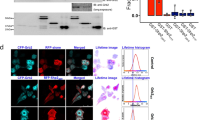Abstract
MANY signal transduction processes are mediated by the binding of Src-homology-2 (SH2) domains to phosphotyrosine (pTyr)-containing proteins1. Although most SH2-pTyr interactions occur between two different types of molecules, some appear to involve only a single molecular type. It has been proposed that the enzymatic activity and substrate recognition of the Src-family kinases2–4, and the protein-binding and transforming activity of Crk-family adaptor proteins5, are regulated by intramolecular SH2-pTyr interactions. In addition, the DNA-binding activity of Stat transcription factors seems to be regulated by SH2-mediated homodimerization6. Here we examine the phosphorylated and non-phosphorylated forms of murine Crk II (p-mCrk and mCrk, respectively)7–9 using a combination of physical techniques. The Crk protein contains a single SH2 domain and two SH3 domains in the order SH2-SH3-SH3. There is a tyrosine-phosphorylation site between the two SH3 domains at residue 221 which is phosphorylated in vivo by the Abl tyrosine kinase5. Using NMR spectroscopic analysis, we show here that the SH2 domain of purified p-mCrk is bound to pTyr, and by hydrodynamic measurements that the phosphorylated protein is monomeric. These results pro-vide direct demonstration of an intramolecular SH2-pTyr inter-action in a signalling molecule.
This is a preview of subscription content, access via your institution
Access options
Subscribe to this journal
Receive 51 print issues and online access
$199.00 per year
only $3.90 per issue
Buy this article
- Purchase on Springer Link
- Instant access to full article PDF
Prices may be subject to local taxes which are calculated during checkout
Similar content being viewed by others
References
Pawson, A. J. Nature 373, 573–580 (1995).
Matsuda, M., Mayer, B. J., Fukui, Y. & Hanafusa, H. Science 248, 1537–1539 (1990).
Roussel, R. R., Brodeur, S. R., Shalloway, D. & Laudano, A. P. Proc. natn. Acad. Sci. U.S.A. 88, 10696–10700 (1991).
Superti-Furga, G., Fumagalli, S., Keogl, M., Courtneidge, S. A. & Draetta, G. EMBO J. 12, 2625–2634 (1993).
Feller, S. M., Knudsen, B. & Hanafusa, H. EMBO J. 13, 2341–2351 (1994).
Shuai, K. et al. Cell 76, 821–828 (1994).
Matsuda, M. et al. Molec. cell. Biol. 12, 3482–3489 (1992).
Reichman, C. T., Mayer, B. J., Keshav, S. & Hanafusa, H. Cell Growth Different. 3, 451–460 (1992).
Ogawa, S. et al. Oncogene 9, 1669–1678 (1994).
Kay, L. E., Keifer, P. & Saarinen, T. J. Am. chem. Soc. 114, 10663–10664 (1992).
Zhang, O., Kay, L. E., Olivier, J. P. & Forman-Kay, J. D. J. Biomol. NMR 4, 845–858 (1994).
Vogel, H. J. Meth. Enz. 177, 263–282 (1989).
Kuryian, J. & Cowburn, D. Curr. Opin. struct. Biol. 3, 828–837 (1993).
Yu, H. & Schreiber, S. L. Nature struct. Biol. 1, 417–420 (1994).
Waksman, G., Shoelson, S. E., Pant, N., Cowburn, D. & Kuryian, J. Cell 72, 779–790 (1993).
Eck, M. J., Shoelson, S. E. & Harrison, S. C. Nature 362, 87–91 (1993).
Pascal, S. M. et al. Cell 77, 461–472 (1994).
Koch, C. A., Anderson, D., Moran, M. F., Ellis, C. & Pawson, T. Science 252, 668–674 (1991).
Matsuda, M., Mayer, B. J. & Hanafusa, H. Molec. cell. Biol. 11, 1607–1613 (1991).
Birge, R. B. et al. Molec. cell. Biol. 13, 4648–4656 (1993).
Sakai, R. et al. EMBO J. 13, 3748–3756 (1994).
Ren, R., Ye, Z.-S. & Baltimore, D. Genes Dev. 8, 783–795 (1994).
Tanaka, S. et al. Proc. natn. Acad. Sci. U.S.A. 91, 3443–3447 (1994).
Matsuda, M. et al. Molec. cell. Biol. 14, 5495–5500 (1994).
Oda, T. et al. J. biol. Chem. 269, 22925–22928 (1994).
Farrow, N. A. et al. Biochemistry 33, 5984–6003 (1994).
Babul, J. & Stellwagon, E. Analyt. Biochem. 28, 216–221 (1969).
Author information
Authors and Affiliations
Rights and permissions
About this article
Cite this article
Rosen, M., Yamazaki, T., Gish, G. et al. Direct demonstration of an intramolecular SH2—phosphotyrosine interaction in the Crk protein. Nature 374, 477–479 (1995). https://doi.org/10.1038/374477a0
Issue Date:
DOI: https://doi.org/10.1038/374477a0
This article is cited by
-
SOCS2 Binds to and Regulates EphA2 through Multiple Mechanisms
Scientific Reports (2017)
-
Cyclophilin A promotes cell migration via the Abl-Crk signaling pathway
Nature Chemical Biology (2016)
-
Iterative tyrosine phosphorylation controls non-canonical domain utilization in Crk
Oncogene (2015)
-
The adaptor protein Crk in immune response
Immunology & Cell Biology (2014)
-
Tony (Anthony James) Pawson, a giant in the field of cell signaling research, dies unexpectedly at the age of 60
Cell Communication and Signaling (2013)
Comments
By submitting a comment you agree to abide by our Terms and Community Guidelines. If you find something abusive or that does not comply with our terms or guidelines please flag it as inappropriate.



